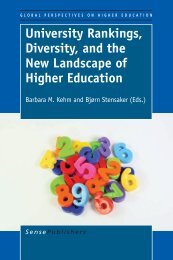Rupturing Concepts of Disability and Inclusion
Rupturing Concepts of Disability and Inclusion
Rupturing Concepts of Disability and Inclusion
Create successful ePaper yourself
Turn your PDF publications into a flip-book with our unique Google optimized e-Paper software.
CHAPTER 1<br />
4<br />
The qualifier social-symbolic indicates that this ordering, though dominant in<br />
a particular historical period or era, is nonetheless a historical construct, <strong>and</strong><br />
thus open to change <strong>and</strong> transformation. ... Around the social-symbolic order<br />
are margins <strong>and</strong> fissures that allow language <strong>and</strong> thus the social-symbolic<br />
order to be corrected, changed, subverted, interrupted, <strong>and</strong> transformed. 14<br />
Such an order which silently, yet definitively, excludes certain people to the<br />
margins <strong>and</strong> beyond, is contained by constructed boundaries which legitimate the<br />
hegemonic centre <strong>of</strong> society. This is a socio-symbolic order co-configured by<br />
patriarchy <strong>and</strong> kyriarchy, for it privileges <strong>and</strong> protects the subjectivity <strong>of</strong> rational,<br />
white, propertied males by inferiorising ‘Others’. As Chopp eloquently states, the<br />
voices <strong>of</strong> the subjects “who suffer history <strong>and</strong> the subjects who control history are<br />
interwoven, forming the warp <strong>of</strong> our lives, the weft <strong>of</strong> our history.” 15<br />
A socio-symbolic order, derived from patriarchal monotheism in the Western<br />
Judeo-Christian tradition, uses God the Father as a ruling sovereign to separate,<br />
divide <strong>and</strong> exclude. 16 As well as the sovereignty <strong>of</strong> masculinity, the traditional<br />
socio-symbolic order <strong>of</strong> Western Judeo-Christian society is also dominated by the<br />
sovereignty <strong>of</strong> reason <strong>and</strong> rationality. Mark Johnson highlights this claim from<br />
both theological <strong>and</strong> non-theological viewpoints. He states theologically:<br />
Among the animals, we alone have duties to obey God’s will, because we<br />
alone are able to discern rationally what is required <strong>of</strong> us, both in our<br />
relations with others, who, like ourselves, are made in God’s image, <strong>and</strong> also<br />
in our dealings with non-rational creation... 17<br />
Drawing from the work <strong>of</strong> Immanuel Kant, he states a non-theological view,<br />
describing that:<br />
Kant’s project was to provide a rational foundation for the non-theological<br />
part <strong>of</strong> the Judeo-Christian tradition, … the part that sees moral laws as<br />
coming out <strong>of</strong> a universal human reason, independent <strong>of</strong> divine reason. 18<br />
Therefore, male humanity, self-ascribed with the superiority <strong>of</strong> reason <strong>and</strong> rationality,<br />
assumes authority to represent the omnipotent God as head <strong>of</strong> the social order in<br />
Western Judeo-Christian society. According to Bryan Turner, the masculine character<br />
<strong>of</strong> God <strong>and</strong> Christ in New Testament Christianity created a social system <strong>of</strong><br />
hierarchical <strong>and</strong> patriarchal power in which women <strong>and</strong> others with embodied<br />
difference to the patriarchal priesthood were assigned to <strong>and</strong> inscribed in inferior<br />
positions. 19 However, these positions have not been differentiated by gender alone,<br />
for as Elisabeth Schüssler Fiorenza highlights, axes <strong>of</strong> power structures <strong>and</strong><br />
domination are linked with notions <strong>of</strong> race, class, culture <strong>and</strong> religion - to which I<br />
add ability. 20<br />
Boundaries are formed to intentionally <strong>and</strong> oppressively exclude those who are<br />
deemed different or anomalous. The weave <strong>of</strong> these boundaries, being dense <strong>and</strong><br />
occluding, provide a definitive edge. For the purposes <strong>of</strong> this research, I will call<br />
these ‘Selvedges <strong>of</strong> Definition’ for their function to recognise or reject, accept or<br />
ignore, proclaim or prohibit, authenticate or illegitimate. 21<br />
Chopp issues a challenge:














